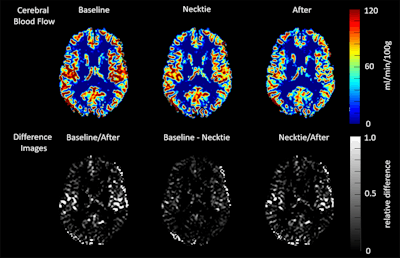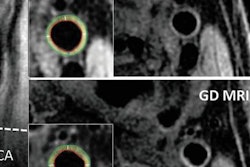
You now have another reason to hate neckties. German researchers using MRI discovered that neckties can constrict blood flow to the brain, according to a study published online June 30 in Neuroradiology.
White-collar professionals have always had plenty of reasons to dislike neckties, but the clinical impact of the neckwear has been less well-known. That began to change in the early 2000s, when researchers started analyzing the possible health risks, ranging from neckties as a vector for transmitting hospital-acquired infections to the possible effect of ties on intraocular pressure.
Dr. Robin Lüddecke and colleagues from University Hospital Schleswig-Holstein in Kiel speculated that tightening a necktie could restrict cerebral blood flow by compressing jugular venous flow. To investigate, they gathered 30 healthy young men with no known cerebrovascular disease and separated them into two groups: 15 were allowed to wear open-collared shirts, while 15 unlucky individuals were assigned to wear neckties.
 MR images show changes in cerebral blood flow in healthy volunteers before, during, and after wearing a necktie. Courtesy of Dr. Robin Lüddecke.
MR images show changes in cerebral blood flow in healthy volunteers before, during, and after wearing a necktie. Courtesy of Dr. Robin Lüddecke.Both groups received baseline MRI scans on a 3-tesla scanner (Achieva, Philips Healthcare). The control group received two more MRI scans, all without a necktie.
Each person in the experimental group underwent the baseline scan with an open collar and loosened necktie around his neck. The shirt collar was then closed and the necktie tightened for the second scan. Finally, for the third scan, the necktie was loosened and collar button opened.
The researchers used an arterial spin labeling (ASL) scanning protocol, with quantitative phase-contrast angiography performed over the jugular vein during a full RR cycle. Cerebral blood flow (CBF) was calculated and venous flow in the jugular vein was measured using software. CBF values were rendered as mL/min/100 g.
In the necktie group, cerebral blood flow dropped by 4.33 mL/min/100 g, or 7.5%, from the baseline scan to the second scan when the necktie was tightened. It was even lower at the third scan, 12.8% from baseline, after the necktie had been loosened. There were no statistically significant changes in CBF in the control group between the different scans.
| Effect of neckties on cerebral blood flow on MRI scans | |||
| Cerebral blood flow | No necktie group | Necktie group | Decline in CBF within necktie group |
| At baseline | 59.68 | 58.02 | |
| At 2nd scan | 60.16 | 53.68 | 7.5% |
| At 3rd scan | 58.19 | 50.61 | 12.8% |
On the other hand, the researchers found no statistically significant changes in flow in the jugular vein.
What caused the phenomenon? Cerebral blood flow is indirectly proportional to intracranial pressure, and compressing the jugular vein could lead to higher pressure by hindering outflow -- even in the absence of a change in jugular venous flow, they wrote. The declines in CBF were within physiological limits, so further research is needed to determine the clinical value of the findings, they added.
The study adds to the body of literature on the negative effects of wearing tight neckties, the researchers concluded. They noted that, fortunately, Palazzo and Hocken found in 2010 that patients do not expect doctors to wear neckties and white coats.



















